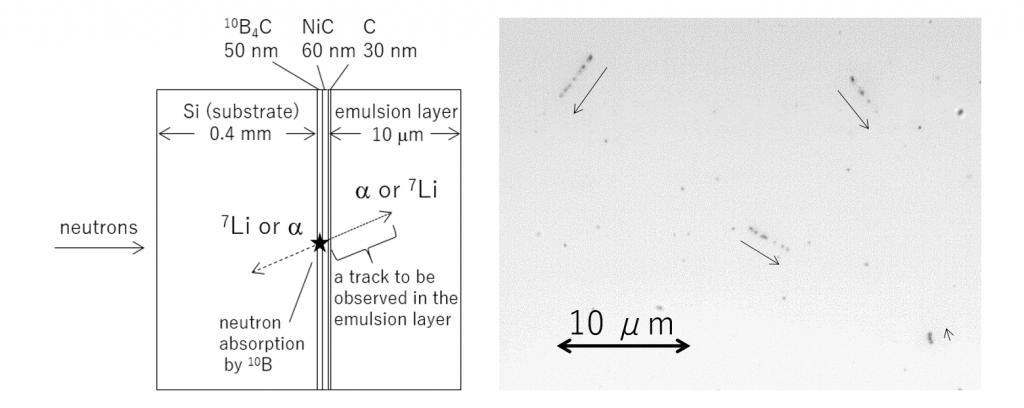[Research] Ultra-high resolution neutron detector with nuclear emulsion
“Neutron is a massive and chargeless particle, which can be used for various precision measurements”, Associate Professor Masaaki Kitaguchi of KMI says. “We have successfully developed a new type of position sensitive detector with extremely-high resolution of 11 nm. It can be a strong tool for experiments with neutrons.”
Nuclear emulsion is used for various experiments for particle physics with muons and neutrinos, which is also applied to imaging through a pyramid today. Nagoya University team is continuing to develop new types of nuclear emulsion with super-fine grains to search dark matter, which is a candidate of unknown mass source in our universe. Dr. Naotaka Naganawa in F-laboratory in Nagoya University applied this emulsion to the thin films with boron layer developed in Kyoto University in order to function it as a neutron detector. It was demonstrated with spatial resolution of less than 100 nm, at most 11 nm, with neutron beam at Material and Life science experimental facility in J-PARC. The resolution is two orders of magnitude higher than that of conventional neutron detectors. This enables us to perform new precision measurements with neutrons, for example, a detection of small shift of neutron spatial distribution due to gravity.
This achievement was done by a research group of Nagoya University, Kyoto University, Kyushu University and KEK. This research is published in The European Physical Journal C on 21st November 2018.

(Right) The track image in the emulsion. Arrows drawn next to tracks show flight directions of alpha particles or ions. The analysis is done by using 3D information.
“Both of nuclear emulsion technique and neutron optics is an advantage of KMI. We are really excited to do experiments, for dark energy or gravity, using this outstanding detector.” — Masaaki Kitaguchi
Paper Information:
The European Physical Journal C, “A cold/ultracold neutron detector using fine-grained nuclear emulsion with spatial resolution less than 100 nm,” (2018)
https://link.springer.com/article/10.1140%2Fepjc%2Fs10052-018-6395-7
Press release (Japanese)
https://www.kek.jp/ja/newsroom/attic/PR20190215.pdf
http://www.nagoya-u.ac.jp/about-nu/public-relations/researchinfo/upload_images/20190215_imass.pdf



